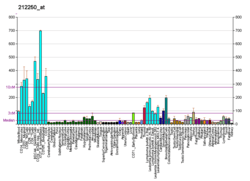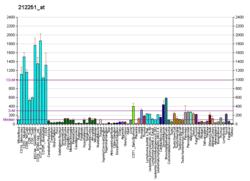MTDH
Metadherin, also known as protein LYRIC or astrocyte elevated gene-1 protein (AEG-1) is a protein that in humans is encoded by the MTDH gene.[5][6][7]
Function
MTDH (AEG-1) is involved in HIF-1alpha mediated angiogenesis. MTDH also interacts with SND1 and involved in RNA-induced silencing complex (RISC) and plays very important role in RISC and miRNA functions.[8][9] MTDH has been shown to interact with spliceosome proteins in the cell nucleus and regulate the process of alternative splicing.[10]
MTDH induces an oncogene called Late SV40 factor (LSF/TFCP2) which is involved in thymidylate synthase (TS) induction and DNA biosynthesis synthesis.[11] Late SV40 factor (LSF/TFCP2) enhances angiogenesis by transcriptionally up-regulating matrix metalloproteinase-9 (MMP9).[12]
Clinical significance
MTDH acts as an oncogene in melanoma, malignant glioma, breast cancer and hepatocellular carcinoma.[13] It is highly expressed in these cancers and helps in progression and development of these cancers. It is induced by c-Myc oncogene and plays very important role in anchorage independent growth of cancer cells.
Elevated expression of the metastasis gene metadherin (MTDH), which is overexpressed in more than 40% of breast cancers, is associated with poor clinical outcomes. MTDH has a dual role in promoting metastatic seeding and enhancing chemoresistance. MTDH is therefore a potential therapeutic target for enhancing chemotherapy and reducing metastasis.[14]
MTDH has been shown to be overexpressed in prostate cancer, where there is a shift towards a more cytoplasmic localisation, signalling a poor prognosis.[15][16] In the nucleus of prostate cancer cells, MTDH has been shown to effect alternative splicing of genes such as CD44 which may also be associated with prostate cancer progression.[10]
LSF/TFCP2 plays multifaceted role in chemo resistance, EMT, allergic response, inflammation and Alzheimer’s disease.[17]
MTDH controls many hallmarks of oncogenes and cancer. MTDH/AEG-1 induces hepato steatosis in mouse liver.[18] The MTDH knockdown by artificial microRNA interference functions as a potential tumor suppressor in breast cancer.[19] Astrocyte elevated gene-1/MTDH undergoes palmitoylation in normal and abnormal physiology of the cell.[20] Biomaterial titanium substrata with microgrooves can alter the expression of MTDH in human primary cells.[21]
References
- GRCh38: Ensembl release 89: ENSG00000147649 - Ensembl, May 2017
- GRCm38: Ensembl release 89: ENSMUSG00000022255 - Ensembl, May 2017
- "Human PubMed Reference:". National Center for Biotechnology Information, U.S. National Library of Medicine.
- "Mouse PubMed Reference:". National Center for Biotechnology Information, U.S. National Library of Medicine.
- "Entrez Gene: MTDH metadherin".
- Brown DM, Ruoslahti E (April 2004). "Metadherin, a cell surface protein in breast tumors that mediates lung metastasis". Cancer Cell. 5 (4): 365–74. doi:10.1016/S1535-6108(04)00079-0. PMID 15093543.
- Sutherland HG, Lam YW, Briers S, Lamond AI, Bickmore WA (March 2004). "3D3/lyric: a novel transmembrane protein of the endoplasmic reticulum and nuclear envelope, which is also present in the nucleolus". Experimental Cell Research. 294 (1): 94–105. doi:10.1016/j.yexcr.2003.11.020. PMID 14980505.
- Yoo BK, Santhekadur PK, Gredler R, Chen D, Emdad L, Bhutia S, et al. (May 2011). "Increased RNA-induced silencing complex (RISC) activity contributes to hepatocellular carcinoma". Hepatology. 53 (5): 1538–48. doi:10.1002/hep.24216. PMC 3081619. PMID 21520169.
- Yoo BK, Emdad L, Lee SG, Su ZZ, Santhekadur P, Chen D, et al. (April 2011). "Astrocyte elevated gene-1 (AEG-1): A multifunctional regulator of normal and abnormal physiology". Pharmacology & Therapeutics. 130 (1): 1–8. doi:10.1016/j.pharmthera.2011.01.008. PMC 3043119. PMID 21256156.
- Luxton HJ, Simpson BS, Mills IG, Brindle NR, Ahmed Z, Stavrinides V, Heavey S, Stamm S, Whitaker HC (September 2019). "The Oncogene Metadherin Interacts with the Known Splicing Proteins YTHDC1, Sam68 and T-STAR and Plays a Novel Role in Alternative mRNA Splicing". Cancers. 11 (9): 1233. doi:10.3390/cancers11091233.
- Yoo BK, Gredler R, Vozhilla N, Su ZZ, Chen D, Forcier T, et al. (August 2009). "Identification of genes conferring resistance to 5-fluorouracil". Proceedings of the National Academy of Sciences of the United States of America. 106 (31): 12938–43. Bibcode:2009PNAS..10612938Y. doi:10.1073/pnas.0901451106. PMC 2722317. PMID 19622726.
- Santhekadur PK, Gredler R, Chen D, Siddiq A, Shen XN, Das SK, et al. (January 2012). "Late SV40 factor (LSF) enhances angiogenesis by transcriptionally up-regulating matrix metalloproteinase-9 (MMP-9)". The Journal of Biological Chemistry. 287 (5): 3425–32. doi:10.1074/jbc.M111.298976. PMC 3270996. PMID 22167195.
- Yoo BK, Emdad L, Su ZZ, Villanueva A, Chiang DY, Mukhopadhyay ND, et al. (March 2009). "Astrocyte elevated gene-1 regulates hepatocellular carcinoma development and progression". The Journal of Clinical Investigation. 119 (3): 465–77. doi:10.1172/JCI36460. PMC 2648696. PMID 19221438.
- Hu G, Chong RA, Yang Q, Wei Y, Blanco MA, Li F, et al. (January 2009). "MTDH activation by 8q22 genomic gain promotes chemoresistance and metastasis of poor-prognosis breast cancer". Cancer Cell. 15 (1): 9–20. doi:10.1016/j.ccr.2008.11.013. PMC 2676231. PMID 19111877.
- Kikuno N, Shiina H, Urakami S, Kawamoto K, Hirata H, Tanaka Y, et al. (December 2007). "Knockdown of astrocyte-elevated gene-1 inhibits prostate cancer progression through upregulation of FOXO3a activity". Oncogene. 26 (55): 7647–55. doi:10.1038/sj.onc.1210572. PMID 17563745.
- Thirkettle HJ, Girling J, Warren AY, Mills IG, Sahadevan K, Leung H, et al. (May 2009). "LYRIC/AEG-1 is targeted to different subcellular compartments by ubiquitinylation and intrinsic nuclear localization signals". Clinical Cancer Research. 15 (9): 3003–13. doi:10.1158/1078-0432.CCR-08-2046. PMID 19383828.
- Santhekadur PK, Rajasekaran D, Siddiq A, Gredler R, Chen D, Schaus SC, Hansen U, Fisher PB, Sarkar D (2012). "The transcription factor LSF: a novel oncogene for hepatocellular carcinoma" (PDF). Am J Cancer Res. 2 (3): 269–285.
- Srivastava J, Siddiq A, Emdad L, Santhekadur PK, Chen D, Gredler R, et al. (November 2012). "Astrocyte elevated gene-1 promotes hepatocarcinogenesis: novel insights from a mouse model". Hepatology. 56 (5): 1782–91. doi:10.1002/hep.25868. PMC 3449036. PMID 22689379.
- Wang S, Shu JZ, Cai Y, Bao Z, Liang QM (2012). "Establishment and characterization of MTDH knockdown by artificial MicroRNA interference - functions as a potential tumor suppressor in breast cancer" (PDF). Asian Pacific Journal of Cancer Prevention. 13 (6): 2813–8. doi:10.7314/apjcp.2012.13.6.2813. PMID 22938464.
- Martin BR, Wang C, Adibekian A, Tully SE, Cravatt BF (November 2011). "Global profiling of dynamic protein palmitoylation". Nature Methods. 9 (1): 84–9. doi:10.1038/nmeth.1769. PMC 3248616. PMID 22056678.
- Lee MH, Kang JH, Lee SW (April 2012). "The significance of differential expression of genes and proteins in human primary cells caused by microgrooved biomaterial substrata". Biomaterials. 33 (11): 3216–34. doi:10.1016/j.biomaterials.2012.01.034. PMID 22285466.
Further reading
- Emdad L, Sarkar D, Su ZZ, Lee SG, Kang DC, Bruce JN, et al. (May 2007). "Astrocyte elevated gene-1: recent insights into a novel gene involved in tumor progression, metastasis and neurodegeneration". Pharmacology & Therapeutics. 114 (2): 155–70. doi:10.1016/j.pharmthera.2007.01.010. PMC 2039930. PMID 17397930.
- van 't Veer LJ, Dai H, van de Vijver MJ, He YD, Hart AA, Mao M, et al. (January 2002). "Gene expression profiling predicts clinical outcome of breast cancer". Nature. 415 (6871): 530–6. doi:10.1038/415530a. PMID 11823860.
- Sutherland HG, Lam YW, Briers S, Lamond AI, Bickmore WA (March 2004). "3D3/lyric: a novel transmembrane protein of the endoplasmic reticulum and nuclear envelope, which is also present in the nucleolus". Experimental Cell Research. 294 (1): 94–105. doi:10.1016/j.yexcr.2003.11.020. PMID 14980505.
- Brown DM, Ruoslahti E (April 2004). "Metadherin, a cell surface protein in breast tumors that mediates lung metastasis". Cancer Cell. 5 (4): 365–74. doi:10.1016/S1535-6108(04)00079-0. PMID 15093543.
- Britt DE, Yang DF, Yang DQ, Flanagan D, Callanan H, Lim YP, et al. (October 2004). "Identification of a novel protein, LYRIC, localized to tight junctions of polarized epithelial cells". Experimental Cell Research. 300 (1): 134–48. doi:10.1016/j.yexcr.2004.06.026. PMID 15383321.
- Kang DC, Su ZZ, Sarkar D, Emdad L, Volsky DJ, Fisher PB (June 2005). "Cloning and characterization of HIV-1-inducible astrocyte elevated gene-1, AEG-1". Gene. 353 (1): 8–15. doi:10.1016/j.gene.2005.04.006. PMID 15927426.
- Olsen JV, Blagoev B, Gnad F, Macek B, Kumar C, Mortensen P, Mann M (November 2006). "Global, in vivo, and site-specific phosphorylation dynamics in signaling networks". Cell. 127 (3): 635–48. doi:10.1016/j.cell.2006.09.026. PMID 17081983.
- Lee SG, Su ZZ, Emdad L, Sarkar D, Fisher PB (November 2006). "Astrocyte elevated gene-1 (AEG-1) is a target gene of oncogenic Ha-ras requiring phosphatidylinositol 3-kinase and c-Myc". Proceedings of the National Academy of Sciences of the United States of America. 103 (46): 17390–5. Bibcode:2006PNAS..10317390L. doi:10.1073/pnas.0608386103. PMC 1859939. PMID 17088530.





